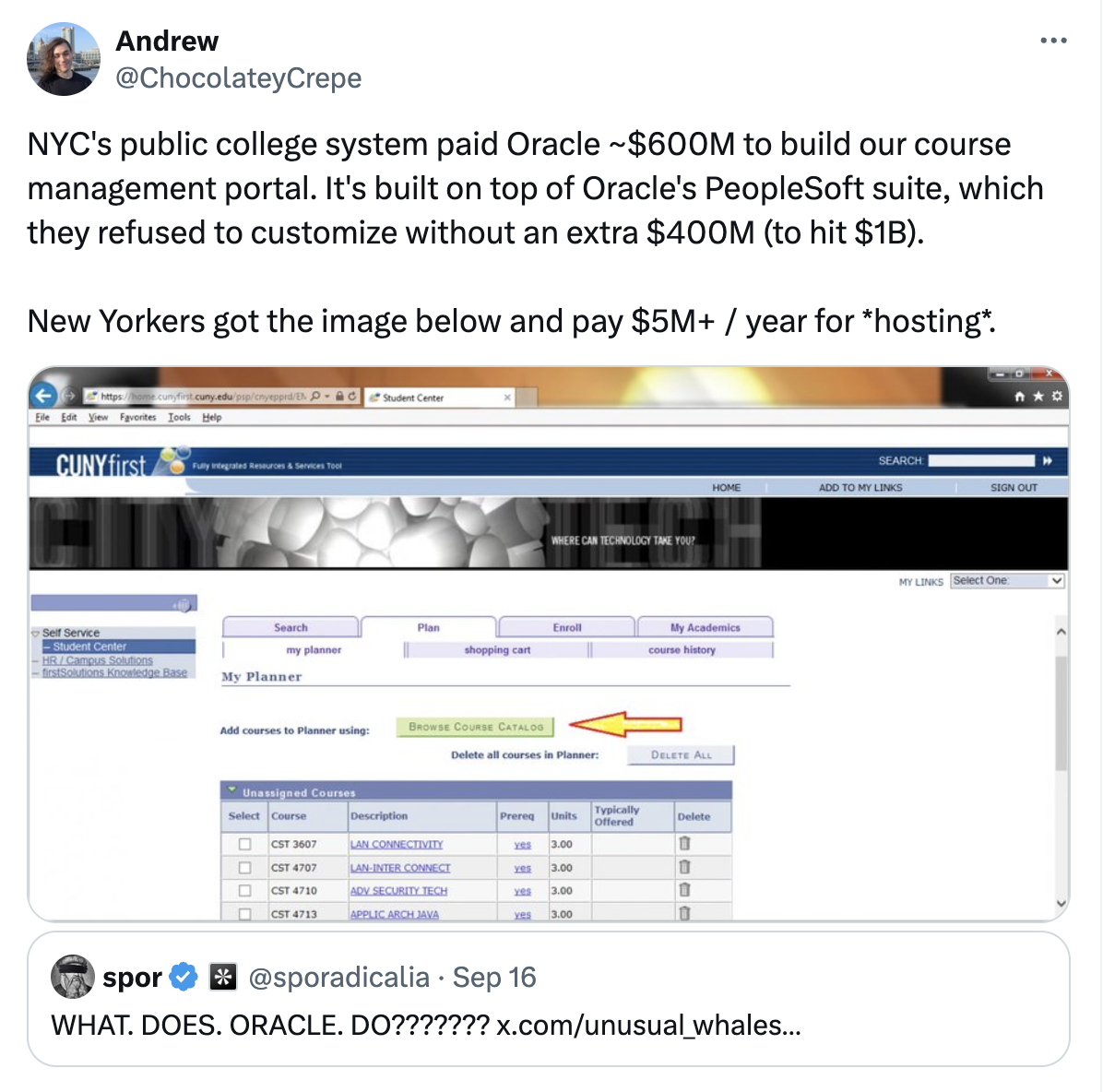Alright. I recently spotted a Tweet that captured the attention of others asking what does Oracle do? Aside from making some nice looking sponsored sail racing boats and logos on Formula 1 cars, what do they really do? The tech giant has seen a better days in their outward image and reputation. At least with modern businesses people are capable of putting a personal face or a product to them. Oracle feels like a dinosaur compared to its more talked about counterparts of today.
The typical answer someone gives is they have something to do with computers or networks. They’re likely confusing them for Cisco or IBM but it’s a fair shot. However, ask a tech person and they too might struggle with vague answers. I know I did. Something about enterprise database software. Maybe some CRM? SAP? Who knows but they’ve been around for a while and have a baseball park named after them.
It’s not incorrect to think the previous statements as they do own enterprise software but that’s likely a reason why they feel like a mystery. The typical consumer simply doesn’t interface with them directly. They’re kind of there just not for you. Most of their history stems back to a time when software was more tailored towards enterprises and alternatives were limited.
But I think the other question being asked is how do they stay profitable? At least from observation and doing a temperature check, it doesn’t appear as if they have raving fans. Maybe they once did in the early days of the internet. You don’t often hear them discussed in the general tech zeitgeist and when you do it’s often negative. Such as the 2021 Google vs Oracle Supreme Court case, Oracle tracking 5 billion people or its intentional complexity. Nor do people generally aspire to work for them as much as the trendy big corps or even a scrappy startup. No one makes a day in the life videos for Oracle or write about how to get into the company.
So what keeps old Oracle afloat?
I’d like to bring attention to this question by looking into a blog article in 2018 titled “Choose Technology Suppliers Carefully”. It’s written by James Hamilton a top renown Amazon Web Services chief engineer at Amazon – who’s credited to have established much of today’s AWS’s data centers and his LinkedIn is written as some type of distinguished biography. He is the guy you call for any problem regarding infrastructure and data at scale. And the correct person to be writing about this talking point.
In this article he brings attention to the early days of Amazon and how they decided to use Oracle’s suite of database products as their provider. It was the correct choice at the time when options were limited. Much to their misfortune, they were unaware of what they had signed up for. Oracle’s products ultimately do their technical job but the problem lies in the non-technical with the Oracle to customer relationship.
It turns out Oracle does a great job of browbeating their clients into a weakened customer negotiating position and then leveraging this weakness as an opportunity for increased costs in software licensing. They stay afloat through unfriendly price increases and licensing audits as your business is slowly consumed by them or what’s called vendor lock-in. They’re not integrating into your business at a superficial level but at a fundamental level – the database. Licensing is intentionally confusing so anyone can make mistakes and be caught red-handed during quarterly audits. Once caught a sales rep comes knocking at your door asking to see those licenses.
And it’s not as simple as leaving for another database provider. Database migrations require plenty of work in coordination and to finance. I’ve been a part of one within a small team of 10 and it required extra expenses and overnight work scheduling so I can only imagine the massive undertaking for Amazon.
Online social media is littered with such examples of people expressing a similar concern about their stranglehold in licensing. Enterprises or IT administrators too afraid to leave the product behind due to high critical risk. Some people writing how they receive massive yearly payouts for selling their software. Most of them legacy businesses taken advantage by Oracle.
One example of this bloat is this article from 2023 that wrote about an internal NASA report where they had overspent $15 million dollars on Oracle software because it was afraid an audit would cost more. The curious part is that it was expenditure on software NASA didn’t use since 2011. The report stated:
Officials in NASA’s office of the CIO told the Office of Inspector General (that’s the aerospace agency’s) they “knew better than to try our luck with an audit.” “Simply put, merely the potential threat of being audited by the vendor encouraged overbuying when the accuracy of Agency Software Asset Management was suspect,” the report states.
So NASA spent $15 million on Oracle software it didn’t use and is likely still spending too much on since 2011 - the year they signed with them. The report continues to say
NASA “could have saved approximately $35 million over the past five years in fines and overpayments ($20 million in penalties plus $15 million in Oracle overspend)” and is therefore questioning the costs.
But due to staffing shortfalls and vendor lock-in it was further deemed difficult to transition away due to proprietary technologies.
“NASA purchased large amounts of Oracle products to support Space Shuttle processing and other mission operations during that timeframe containing licensing terms that made transitioning to a competitor difficult due to proprietary technologies,”
Funny enough, during the edit of this draft, I discovered this Twitter post where NYC’s public college system paid Oracle ~$600M to build their course management. I tracked it down to this blog post from 2013. It’s managed by Brooklyn College PSC Chapter’s Executive Committee (EC). In this post they mention how the actual cost far exceeds the 600 million that go to Oracle for a system that makes things worse everywhere it goes.
(4) And thus, CUNY has spent about $600 million dollars on a system that makes things worse everywhere it goes. The actual cost far exceeds the $600 million dollars that go to Oracle. Because processes are now much more inefficient, more people have to be hired to do tasks that were formerly automated.

And here’s a picture of the interface.
Since most of their software is closed source, when anything goes wrong, support is available for a price and why processes are now less efficient while more people are hired to do tasks that were once automated. The price of 600M for a student catalog just doesn’t match market rates – it’s beyond its punching line. It hurts to think how much students or tax payers paid the brunt of it. I don’t believe that’s a 600 million course management system worthy of its costs or as the post states: (5) CUNYFirst does work. It just works badly.
So why would a business keep paying these unwanted licensing fees?
Well if we reference Hamilton’s article there’s a nugget of corporate truth and it’s stated simply that customer client relationships will put up with a lot. Everyone is too busy serving the needs of their customers and put off the problem until later. Your customers are your lifeblood so any non-critical task gets shifted for later, at least until their limits are reached. Corporations have the money to pay off the problem until a later time and startups are far too occupied doing what their name implies – starting up. So is Oracle like the mean step-mother you tolerate?
It does make you wonder how they were able to embed themselves in the first place. At first it seemed strange given the amount of information about their practices but then it came into place. They aren’t selling to people who can program, have time or knowledge but to institutions who prefer to outsource the thinking elsewhere. Their longevity and financial success suggest they must be providing value to their customers. I believe this is where Oracle shines, they target institutions who want an optimized solution where they can leverage support and perhaps shift the blame once something goes wrong. It’s for places that require zero downtime such as banks and governments that want rock solid performance, a business history and security through obscurity.
Someone jokingly said Oracle doesn’t have customers, it has hostages. They’re hopping you believe moving your database elsewhere is too difficult to finance, schedule, and never take action to leave. And who better to have non other than mega companies, banks, educational systems and governments as your hostages.
In any case they are worth $465 billion dollars and making sweet amounts of money, alongside sleek looking jackets.
